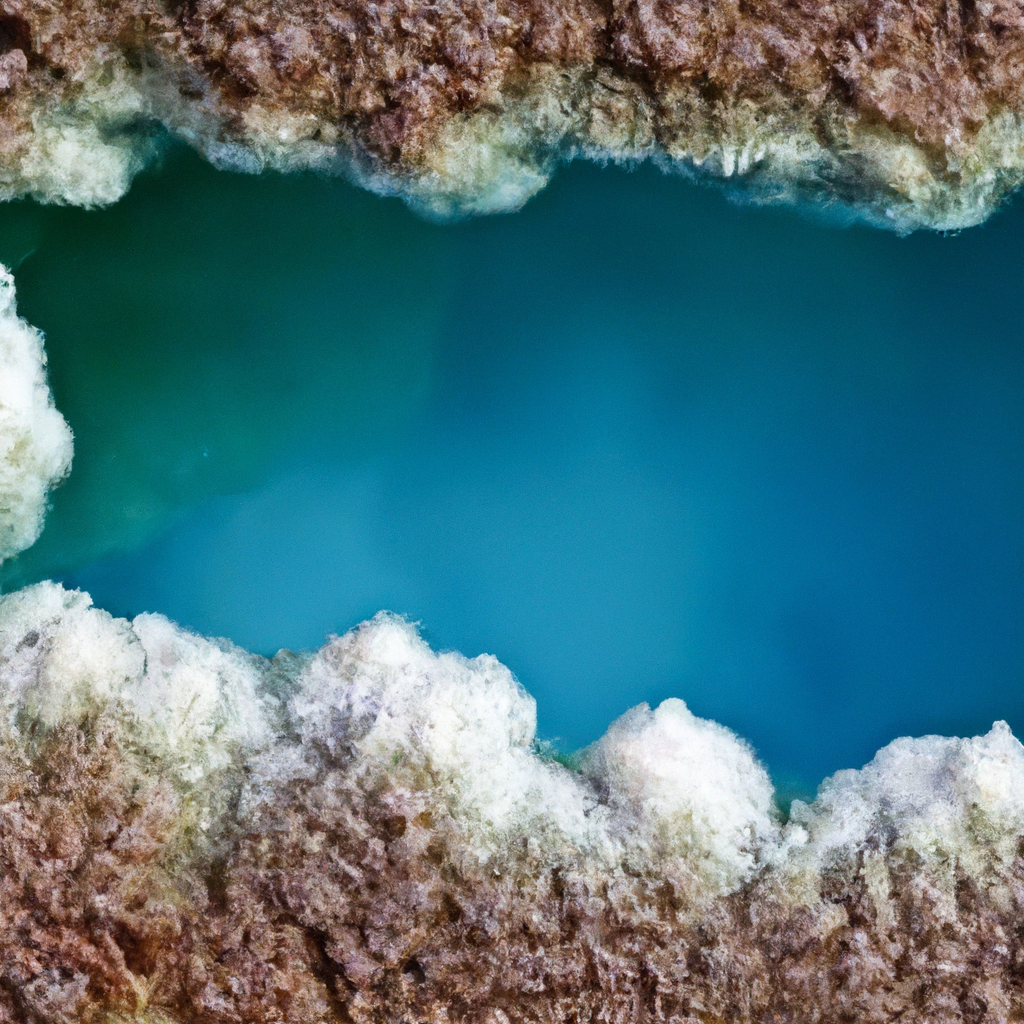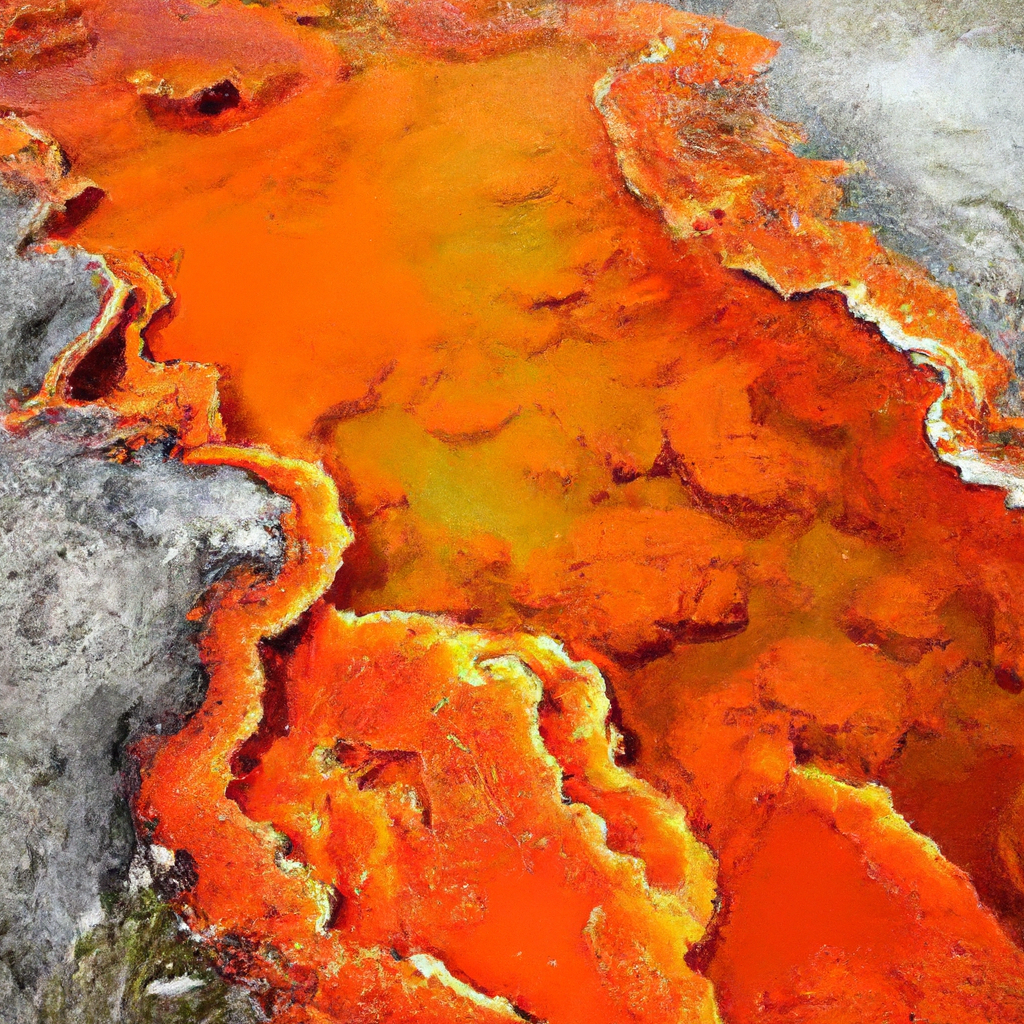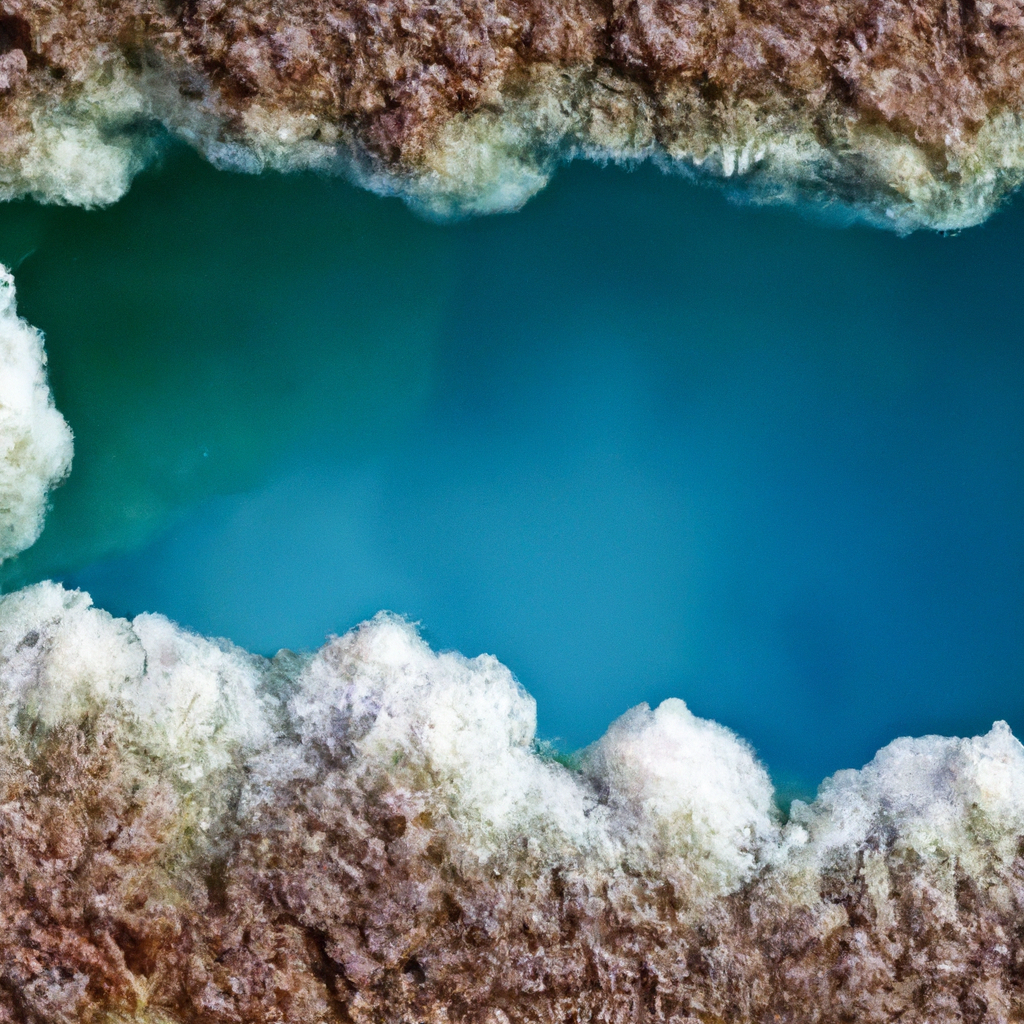Intriguing discoveries await you as we unveil the rare and unique mineral compositions found within U.S. hot springs. These natural underground wonders have been quietly forming for centuries, creating an unlikely blend of minerals that are both captivating and scientific marvels. With colors and patterns that rival the most vibrant paintings, these mineral compositions reveal a hidden world beneath the earth̵7;s surface that is just waiting to be explored. So get ready to embark on a fascinating journey through these remarkable natural formations and uncover the secrets of these extraordinary hot springs.

Geological Background
Hot springs are natural bodies of water that are heated by geothermal energy beneath the Earth’s surface. They can be found all over the world, including the United States. The formation of hot springs is a complex process that involves the movement of underground water, the interaction with magma and rocks, and the release of heat from the Earth’s interior.
Formation of Hot Springs
Hot springs are formed when water from rainfall and snowmelt seeps into the ground and is heated by the magma chambers beneath the Earth’s crust. As the water is heated, it rises back to the surface, creating a hot spring. The heat source for hot springs can come from either volcanic activity or the natural geothermal gradient of the Earth.
Sources of Minerals
One of the distinguishing features of hot springs is their high mineral content. The water in hot springs picks up minerals as it travels through the rocks and soils. These minerals can include calcium, magnesium, silica, sulfur, and many more. The composition of minerals in hot springs varies depending on the geology of the area.
Factors Affecting Mineral Composition
Several factors can influence the mineral composition of hot springs. One of the main factors is the type of rock that the water comes into contact with. Different rocks contain different minerals, which can then dissolve into the water. Another factor is the temperature of the water, as higher temperatures can increase the solubility of certain minerals. Additionally, the length of time the water spends underground can also affect the mineral content.
Hot Springs in the Western United States
The western United States is known for its abundance of hot springs. Here are three popular hot spring locations in the region:
Yellowstone National Park
Yellowstone National Park is home to one of the largest concentrations of hot springs in the world. The park’s famous features, such as the Old Faithful geyser and the Grand Prismatic Spring, attract millions of visitors every year. The hot springs in Yellowstone are known for their vibrant colors, caused by the presence of thermophilic bacteria and unique mineral deposits.
Calistoga, California
Located in the Napa Valley region, Calistoga is known for its geothermal hot springs and mud baths. The mineral-rich waters of Calistoga’s hot springs are believed to have therapeutic properties and are a popular destination for relaxation and wellness retreats.
Pagosa Springs, Colorado
Pagosa Springs is a small town in southern Colorado that is famous for its natural hot springs. The hot springs in Pagosa Springs offer a range of temperatures and mineral compositions, making it a popular destination for both relaxation and outdoor recreation.
Hot Springs in the Midwestern United States
While the Midwest is not as well-known for its hot springs as the western United States, there are still several notable locations in the region:
Hot Springs, South Dakota
Hot Springs, South Dakota, is home to several hot springs that are known for their mineral-rich waters. The town also features a historic bathhouse that dates back to the late 19th century, offering visitors a unique glimpse into the area’s spa culture.
French Lick, Indiana
French Lick, Indiana, is another Midwestern town that is famous for its hot springs. The French Lick Resort, built around the town’s famous Pluto Mineral Springs, has been attracting visitors since the 19th century. Today, the resort offers spa treatments and mineral baths, allowing guests to experience the healing properties of the hot springs.
Eureka Springs, Arkansas
Eureka Springs, Arkansas, is a charming town known for its Victorian architecture and natural beauty. The town is also home to several hot springs, which have been attracting visitors for over a century. The thermal waters of Eureka Springs are believed to have healing properties and are used in a variety of spa treatments.
Hot Springs in the Eastern United States
While hot springs are less common in the eastern United States, there are still a few notable locations in the region:
Saratoga Springs, New York
Saratoga Springs, New York, has a long history of hot springs usage dating back to Native American tribes. The mineral springs in Saratoga are renowned for their unique mineral composition, which includes high levels of carbon dioxide and trace amounts of minerals like iron and sulfur. The town is known for its spa culture and is a popular destination for wellness tourism.
Hot Springs, North Carolina
Hot Springs, North Carolina, is a small town nestled along the Appalachian Mountains. The town’s hot springs are known for their high mineral content and are often used in therapeutic treatments. Visitors to Hot Springs can also explore the nearby hiking trails and enjoy the natural beauty of the area.
Warm Springs, Virginia
Warm Springs, Virginia, is home to the historic Jefferson Pools, a natural hot springs bathhouse that dates back to the 18th century. The mineral-rich waters of Warm Springs have long been believed to have healing properties and attract visitors from near and far.

Rare and Unique Minerals Found in U.S. Hot Springs
Apart from their therapeutic and recreational value, U.S. hot springs are also known for their rare and unique mineral compositions. Here are some of the minerals commonly found in hot springs:
Siliceous Sinter
Siliceous sinter, also known as geyserite, is a type of mineral deposit that forms around hot springs. It is composed of silica, which is derived from the dissolution of silicon dioxide in the water. Siliceous sinter often forms colorful terraces and unique structures, adding to the visual appeal of hot springs.
Travertine
Travertine is a type of limestone deposit that forms in hot springs. It is composed of calcium carbonate, which precipitates out of the water as it cools and evaporates. The mineral is often responsible for the formation of terraces and cascades in hot spring areas.
Calcite
Calcite is a common mineral found in hot springs. It is calcium carbonate that forms from the precipitation of dissolved calcium ions in the water. Calcite can form intricate structures and can be found in various colors, ranging from white to yellow to orange.
Sulfur Deposits
Some hot springs contain high concentrations of sulfur, which leads to the formation of sulfur deposits. These deposits can vary in color and can range from bright yellow to orange or even green. Sulfur deposits are often associated with a distinctive smell of rotten eggs due to the presence of hydrogen sulfide gas.
Thermophiles: Microbes Living in Hot Springs
Hot springs are not only home to unique mineral compositions but also to a wide variety of microorganisms known as thermophiles. These heat-loving organisms have adapted to the extreme conditions of hot springs and have unique metabolic capabilities.
Bacteria
Many thermophilic bacteria thrive in hot springs, including species of Thermus, Chloroflexus, and Aquifex. These bacteria have specialized enzymes that allow them to survive and reproduce at high temperatures. Some bacteria can even convert inorganic compounds, such as sulfur or iron, into usable energy.
Archaea
Archaea are another group of microorganisms that are commonly found in hot springs. One well-known group of thermophilic archaea is the Crenarchaeota, which can withstand high temperatures and are often found in extreme environments like hot springs. These archaea play important roles in the nitrogen and sulfur cycles and contribute to the overall ecosystem of hot springs.
Hot Springs as Geological and Biological Significance
Hot springs have significant geological and biological importance. They are not only fascinating natural phenomena but also provide valuable insights into the Earth’s processes and support diverse ecosystems.
Formation of Hot Springs and Tectonic Activity
The presence of hot springs in certain areas can indicate tectonic activity beneath the Earth’s surface. Hot springs often occur in regions with volcanic or geothermal activity, where magma chambers and geothermal gradients are present. By studying the formation and distribution of hot springs, scientists can gain a better understanding of the dynamics of tectonic plates and the processes that shape the Earth’s crust.
Biodiversity and Ecological Importance
Hot springs support a rich biodiversity of microorganisms, plants, and animals that have adapted to the extreme conditions. These ecosystems are often home to unique and specialized species that cannot survive in other environments. The microbial communities in hot springs play important roles in nutrient cycling and can have significant impacts on the overall ecology of the area.
Implications for Biotechnology and Geothermal Energy
The unique mineral compositions and diverse microbial communities found in hot springs have important implications for biotechnology and the production of geothermal energy.
Minerals with Potential Industrial Applications
The rare and unique minerals found in hot springs have the potential for various industrial applications. Siliceous sinter, for example, can be used in the production of ceramics and other heat-resistant materials. Calcium carbonate deposits, such as travertine and calcite, can be used in construction materials, including tiles and countertops. Sulfur deposits can be processed to obtain sulfur for various industrial purposes.
Geothermal Energy Generation
Hot springs are valuable sources of geothermal energy. The heat from hot springs can be harnessed and used for electricity generation and heating applications. Geothermal power plants utilize the steam or hot water from hot springs to drive turbines and produce electricity. The development of geothermal energy can contribute to renewable energy production and reduce dependence on fossil fuels.
Challenges and Concerns for Hot Springs Preservation
While hot springs offer numerous benefits, there are also challenges and concerns regarding their preservation and sustainability.
Tourism Impact on Hot Springs
The popularity of hot springs among tourists can have both positive and negative impacts. Increased tourism can bring economic benefits to local communities but can also lead to overuse and degradation of the natural resources. It is crucial to manage tourism in a sustainable way to preserve the natural beauty and cultural significance of hot springs.
Climate Change and its Effects
Climate change poses a significant threat to hot springs ecosystems. Rising temperatures and changes in precipitation patterns can alter the delicate balance of hot springs, affecting both the mineral composition and the microbial communities. Climate change mitigation and adaptation strategies are essential to protect these unique environments for future generations.
Water Pollution and Contamination
Hot springs can be vulnerable to pollution and contamination from human activities. Improper waste disposal, the use of harmful chemicals, and the introduction of non-native species can degrade water quality and disrupt the natural balance of hot springs ecosystems. Protecting the water quality of hot springs is vital for the preservation of their ecological integrity.
Future Research and Discoveries
There is still much to learn about hot springs, and ongoing research and exploration can lead to exciting discoveries and advancements in various fields.
Emerging Technologies
Advancements in technology, such as molecular biology and geochemical analysis, are enabling scientists to study hot springs ecosystems in greater detail. These technologies can help identify new microbial species, characterize their metabolic capabilities, and uncover novel compounds with potential applications in medicine and industry.
Exploration of Unexplored Hot Springs
Despite considerable research, many hot springs around the United States remain unexplored. These uncharted hot springs offer the potential for new discoveries and can contribute to our understanding of the diversity and evolution of life. Future expeditions and surveys can uncover hidden treasures and expand our knowledge of these remarkable environments.
Understanding the Role of Minerals in Ecosystems
Minerals play a crucial role in hot springs ecosystems, influencing the growth and survival of microorganisms and providing essential nutrients for plants and animals. Further research is needed to understand the intricate interactions between minerals and biological processes in hot springs. This knowledge can help us appreciate the complexity of these ecosystems and develop strategies for their conservation.
In conclusion, hot springs in the United States are not only geological wonders but also havens for unique mineral compositions and thriving ecosystems. From the colourful terraces of Yellowstone to the historic bathhouses of Saratoga Springs, hot springs offer a diverse range of experiences and opportunities for scientific exploration. By understanding their formation, studying their biological significance, and harnessing their potential for biotechnology and geothermal energy, we can ensure the preservation and sustainable use of these natural treasures for generations to come.
